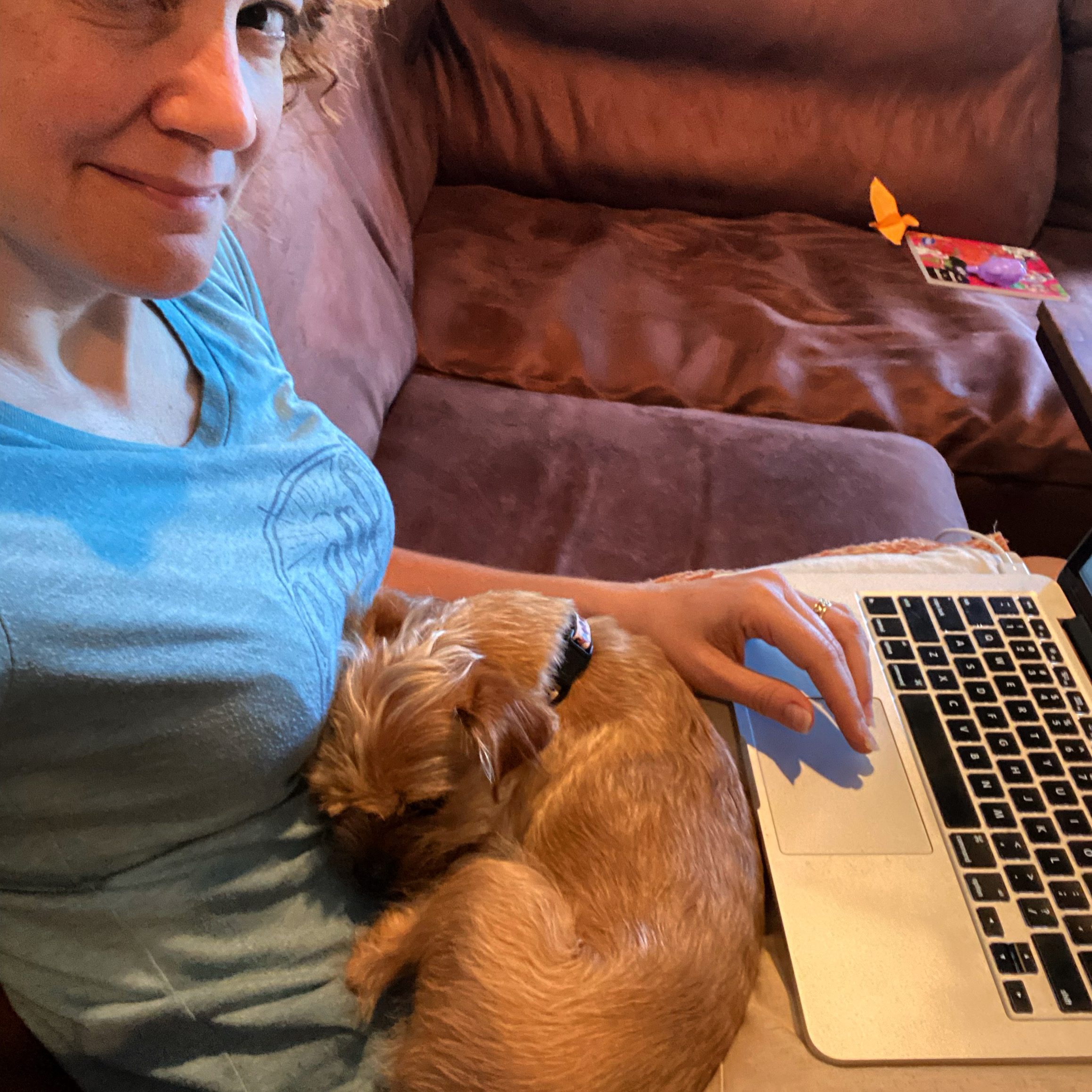A bit of a tangent today. I spent my morning cutting my dogs’ hair, clipping their nails, giving them baths….So, with all the hours I spent giving my girls “spa treatments” this morning, my brain had lots of time for reflection. Specifically, I was thinking back on all the years I’ve had with Kida, my 18 ½ year old Brussels Griffon.
I marvel every day at Kida’s spunk. We nicknamed her “Moose” shortly after we adopted her, as she was strong and stubborn and NOTHING phased her or got her down. She came to us very ill, and with crippling anxiety, but she never acted sick or weak. And 18 years later, she’s got the same temperament. At the age of 15, our vet diagnosed Kida with kidney and liver failure. At 16 she lost most of her vision, and a few months later became completely blind. She’s had a significant hearing loss for a while now, and is mostly deaf. She has arthritis in her hips. But she also eats like a champ, loves “nose work” (activities where she has to find treats by sniffing out their location), and adores snuggles with her daddy. She wakes up renewed every day, and somehow just never seems to mind her pain, discomfort, or lack of ability to do what she used to. She truly enjoys her life, and does what she can each day to LIVE her life. It’s amazing.
I’ve done what I can on my part to support her. Obviously, the diagnosis of a chronic illness, particularly one that is degenerative and has no cure, is devastating. When my first pet was diagnosed with kidney issues, I broke down, went through all the grief, and came out determined to give him the best life possible. For each of my ensuing babies I’ve done the same. I’m happy to say that my two boys lived three years beyond the timeline given by our vet, and Kida is already over three years beyond what was expected. She had a senior wellness workup last week, and, though the vet initially questioned my natural methods, she told me to “keep doing what you’re doing” after she saw the lab results: Kida’s current levels on all of her tests are the same as her initial work up at the age of 15!
I’m not here saying that the vets are wrong in their thinking, or that natural methods are the Valhalla and will keep your pets alive forever. But I do think that Kida is much healthier with the support I give her, and obviously my track record indicates that all of my babies, so far, have lived much longer lives than expected. More importantly, they’ve had a much greater quality of life. And seeing them thriving and happy, watching them enjoy not only their prime but also their senior years, makes all of the research and preparation and outside-the-box thinking totally worth it.
So what does natural pet health look like? Well, it’s pretty much the same as natural health for humans. A good diet, exercise, a sense of purpose, time for play. Making sure their bodies, minds, and spirits are cared for and thriving. Meeting health challenges and illness by supporting their systems to help their bodies thrive.
First and foremost, as with humans, a good diet is essential. Cheap kibble doesn’t cut it. In fact, dogs thrive on a blend of fresh meat and veggies (grains are highly debated; I just go by each dog- right now I have one that needs grains and one that needs grain free). After making the kibble mistake with my first dogs, I did tons of research and made a homemade diet for their later years, then reformulated the ingredients each time they were diagnosed with something else. For my girls now, we use a freeze-dried raw meal that contains balanced nutrients. Real food is best, but there are also do-able kibbles out there if all else won’t work for you. Watch the treats, too- most are like junk food for your pet and made with some really yucky stuff! Again, limit treats and look at the ingredients before you buy. In general, whole, real food ingredients are best. You can also research what real food your pet can have (some human food is toxic to pets): my girls love raw baby carrots and raw green beans as a treat; my boys did better with bits of apples.
Next: exercise. Just like people, most dogs live a pretty sedentary lifestyle. Chances are your pet could use some more movement in his or her life. Are they going on walks? Runs? Playing games of tug and fetch? What can you add daily or weekly to get them moving more, in a way that is beneficial? We love hiking and camping and all kinds of outdoor activities, so my pets have lots of movement opportunities. However, they have each needed and preferred different things, and I’ve customized my approach. Right now, my younger girl Nessie loves to all-out RUN at top speed, but Kida can’t do more than a few minutes of shuffling. They are given opportunities daily to do what they love and are capable of enjoying.
And let’s not forget their mind and spirit! Animals of all kinds- even the human ones- do best with enrichment activities. In the past, my boys enjoyed hide and seek with treats, or bobbing for frozen peas in a shallow dish of water. Right now Kida is enjoying nose work; she’s an expert at sniffing out and locating what I hide. We also have multiple dog games that we’ve bought in specialty stores; Kida loves the ones where treats are hidden in compartments that need to be slid open, but Nessie has no patience for that. She prefers brute force, she loves to knock around a wobble ball that dispenses treats, or flinging around a bandana that has treats loosely wrapped inside. I’ve also started training Nessie to “talk” using AAC buttons made by Fluent Pet (check them out HERE), so she’s getting some mental workouts that she seems to be enjoying- on most days, at least.
As with my human clients, each pet needs to be considered as an individual. They all have different personalities, different likes and dislikes, and different constitutional makeups that need to be considered. If you’re looking to customize a wellness plan for your pet, I can help get you started! We can explore options for nutrition, supplements, exercise, enrichment… there are endless possibilities to help you create the best life for your beloved pet.
Blessings,
Melanie


